The Georgia Peanut Tour got started today. You can get a detailed overview of where they’re going from Amanda Smith, chairman of the Georgia Peanut Tour Committee. Follow along on the blog, Twitter and Facebook.
The 24th Annual Georgia Peanut Tour kicked off this week in Americus, Ga., with a Hot Topics Seminar at the Sumter County Extension Service Office. The Hot Topics Seminar provided updates on the University of Georgia College of Agriculture and Environmental Sciences (UGA CAES) and included a special focus on harvesting and post harvest storage along with information on the 2010 peanut crop. The tour continues Sept. 15 and 16 in the surrounding area.
Distillers Grains Export Opportunities
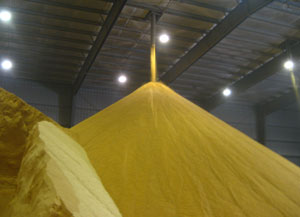 Distillers grains exports are climbing to new heights.
Distillers grains exports are climbing to new heights.
Exports of the ethanol co-product distillers dried grains with solubles (DDGS) hit a new record in July of 886,300 metric tons – which is more than was exported in the entire year in 2004. Total exports this year so far are 4.95 million metric tons, getting close to the total last year of 5.65 million.
Geoff Cooper, VP of Research with the Renewable Fuels Association (RFA), says 2005 was really the first year that DDGS exports started to take off. “2005 was the first year that we exported more than one million metric tons and the growth has been very rapid since then,” Cooper said. This year, the U.S. ethanol industry is on pace to export 8.5 million metric tons of DDGS, or about 28% of expected total DDGS production.
One third of the nation’s ethanol production ends up as DDGS, a high quality animal feed which can be used for everything from cattle to fish, and livestock producers in other countries have been quick to see the advantages of feeding the protein rich product to their animals. Cooper says the U.S. Grains Council (USGC), along with other companies and organizations, have been promoting those advantages to help exports grow.
“Education is what’s going to sell your product,” said Cooper. “And we are seeing the fruits of that work in dramatically increased exports.”
Listen to or download my interview with Geoff Cooper here: Geoff Cooper Interview
USGC and RFA are sponsoring a conference to grow the export opportunities for DDGS. The Export Exchange is being held October 6-8 at the Hyatt Regency McCormick Place Hotel in Chicago, Ill. More information and registration is available on-line here.
Support NAFB Foundation
 Here’s a call out for support of the National Association of Farm Broadcasting Foundation. You can donate an item to the annual auction at the NAFB Convention or just send cash!
Here’s a call out for support of the National Association of Farm Broadcasting Foundation. You can donate an item to the annual auction at the NAFB Convention or just send cash!
Generous donations in past years have helped provide financial support and educational opportunities for young people in pursuit of careers in agricultural communications. Each year, six college students – three scholarship recipients and three station and network interns – directly benefit from your kindness and care for the future of the industry.
In addition to this important work of supporting these future agricultural communicators, the Foundation Board is also currently working on new ways to supply funding for stations and networks who would like to increase their voice for advocacy of agriculture.
Please fill out and submit the contribution form found here (pdf) at your earliest convenience to contribute to this great cause and wonderful event. If you have any questions, please contact the NAFB office at 816.431.4032 or send an email to jennifer@nafb.com.
Urban Wheat Field
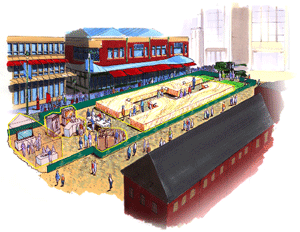 If you can’t take policy makers to the field then take the field to the policy makers.
If you can’t take policy makers to the field then take the field to the policy makers.
On Thursday, September 23rd and Friday, September 24th a live wheat field, approximately one quarter of an acre in size, will sprout from the streets of the nation’s capital in an effort to promote food literacy via farm-to-fork wheat education. The North Dakota Wheat Commission along with fellow members of the nation’s wheat industry will unite to deliver an authentic experience to city dwellers and key influencers during the Wheat Foods Council’s second Urban Wheat Field. The event will take place on Maryland Avenue between 3rd and 4th streets.
Coming off the success and excitement of New York’s Urban Wheat Field in 2008, the Wheat Foods Council is looking forward to strengthening their message and enhancing the experience at the Washington, D.C. event.
Experts in the areas of wheat agriculture, milling, baking and nutrition will guide visitors through each phase of the grain’s life cycle, engaging them in hands-on activities and demonstrations along the way. “This is a great opportunity to reach the urban population who may not be familiar with the agriculture industry or completely understand where their food comes from. They will be able to see the farm-to-fork process firsthand,” said Erica Olson, North Dakota Wheat Commission marketing specialist. The wheat on display is a hard red spring wheat variety grown in the Northern Plains.
Preceding the event, the National Association of Wheat Growers will host a reception for congressional staff members to experience the event and meet with representatives from their individual state wheat commissions.
Ethanol is Right Here, Right Now
There are so many reasons to support American energy independence it sometimes amazes me how many special interest groups or ill informed people oppose it. Sure, we work with groups like the Renewable Fuels Association but we’d support the industry and ethanol anyway. It’s good to see that RFA will make sure lawmakers keep ethanol in mind when they get back to work.
As Congress returns to work for the final weeks before the fall elections, the Renewable Fuels Association (RFA) will greet them with a television ad on MSNBC’s Morning Joe news program. “Right Here, Right Now” is an updated ad that highlights the innovative, job-creating engine that is the American ethanol industry. This ad reminds viewers that the answer to a cleaner environment and reducing our dependence on foreign oil is available “Right Here, Right Now”.
The thirty second ad will air on Morning Joe between September 15th and October 12th in the Washington, DC media market. Nine spots per week. Morning Joe is a show viewed heavily by policy makers and influentials on Capitol Hill, in the White House, and all points in between. Morning Joe airs from 5am – 9am Eastern.
Roger Ward Receives Agriculture Award From Illinois State Fair
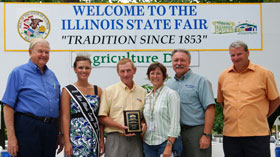 I worked along side him at Farm Progress Show and did not know I was in the presence of greatness.
I worked along side him at Farm Progress Show and did not know I was in the presence of greatness.
Roger Ward, Farm Director of WLDS 1180AM in Jacksonville, was named the 2010 Service to Agriculture Award recipient at the Illinois State Fair Agriculture Day Luncheon on August 17. The award is sponsored by Farm Credit Services of Illinois and recognizes individuals with extraordinary career contributions to the agriculture industry. Roger has been a part of WLDS Farm Broadcasting for more than 25 years. He joined the WLDS team in 1983 and became the full time Farm Director in 2001.
In the photo from left to right: Orion Samuelson, WGN Radio/RFD TV; Haley Freeman, Miss Illinois County Fair 2010; Roger and Cathy Ward; Mike Loyd, Farm Credit Services of Illinois; and Tom Jennings, Illinois Department of Agriculture Director.
Zimfo Bytes
- Four of Southern California’s largest family-owned egg farms have announced the formation of Southern California Egg Cooperative, a new egg marketing cooperative.
- Farm Industry News editor Karen McMahon received the Ruth White Media Award from the Mid American CropLife Association.
- The National Agri-Marketing Association’s next webinar will be Thursday, Sept. 30, at 3:00 central time. Meredith Stevens, digital marketing manager at National Cattlemen’s Beef Association, will be presenting this webinar on social media.
- USDA has released “The Role of Agriculture in Reducint Greenhouse Gas Emissions.”

Corn Farmers Will Reach New Heights
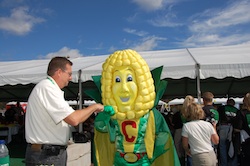 The Iowa Corn Growers Association (ICGA) is focused on reaching out to Iowans and consumers to tell them about the value of Iowa corn farmers. One avenue in which they do this, is through their sponsorship of the Cy-Hawk series and last Saturday, the University of Iowa beat Iowa State in the football game known as the Super Bowl of Iowa. ICGA was there to tell consumers about all of the products that contain corn.
The Iowa Corn Growers Association (ICGA) is focused on reaching out to Iowans and consumers to tell them about the value of Iowa corn farmers. One avenue in which they do this, is through their sponsorship of the Cy-Hawk series and last Saturday, the University of Iowa beat Iowa State in the football game known as the Super Bowl of Iowa. ICGA was there to tell consumers about all of the products that contain corn.
ICGA CEO Craig Floss said that during the game, they were able to get out advertising messages and talk about the importance of Iowa’s corn fed economy and what corn means to the job outlook and picture in Iowa. They were also able to tell the story of how ethanol fits into the picture and what that means for Iowa corn farmers.
A lot of people don’t understand that there is no competition between food, feed, fuel, and fiber. You can find corn in any of these products, said Floss, and he also explained that anything that can be made from petroleum can also be made from corn.
“We hope and we know that the majority of Iowans, 80 plus percent of Iowans, use ethanol every day, which means everywhere they go, they’re using something produced from a corn grower,” said Floss.
The big game happened to fall on 9-11 this year, a day that most of us will never forget. I asked Floss why this day is so important to Iowa’s corn farmers.
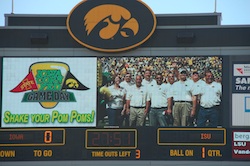 “There is no other liquid form of petroleum product like ethanol that can actually replace foreign produced oil. And the bulk of our oil comes from countries that have governments that are not like ours,” said Floss. He continued that everyone was touched by the event and has a connection to the event and we need to find a way to send less money to those countries. That is why we like corn farmers. They’re good for our economy and good for our security.
“There is no other liquid form of petroleum product like ethanol that can actually replace foreign produced oil. And the bulk of our oil comes from countries that have governments that are not like ours,” said Floss. He continued that everyone was touched by the event and has a connection to the event and we need to find a way to send less money to those countries. That is why we like corn farmers. They’re good for our economy and good for our security.
Floss concluded that corn farmers will continue to exceed the needs of all those products that need corn and that we haven’t seen anything yet.
You can see pictures from game day in the Iowa Corn Fed Game Day photo album.
You can listen to my interview with Craig Floss here. Iowa Corn Farmers Will Reach New Heights
AgChat On Farm Safety
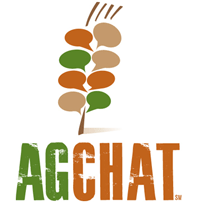 This evening I’ll be moderating the weekly AgChat conversation on Twitter. I hope you’ll tune in and participate. Our topic is farm safety. Next week is National Farm Safety & Health Week so we thought it would be timely, especially with harvest underway in many areas.
This evening I’ll be moderating the weekly AgChat conversation on Twitter. I hope you’ll tune in and participate. Our topic is farm safety. Next week is National Farm Safety & Health Week so we thought it would be timely, especially with harvest underway in many areas.
I’ve got a number of questions to pose during the session but feel free to email me any you have or DM them directly to the AgChat Twitter Account.
If you can participate I recommend you use a web service like Twubs or TweetChat. You can also just search Twitter for the AgChat hashtag which is #AgChat. Make sure you use it in your tweets from 8-10pm ET this evening. I hope to see you there!
Post Update: We had a great AgChat conversation tonight. Here are the questions. See the transcript on the AgChat Foundation website posted soon.
Q1 How does technology help with operator safety during harvest? via @mpaynknoper
Q2 How do we keep children safe during harvest time? via @ezweber
Q3 What level of training are farmers/ranchers needing for farm safety and compliance with state/fed regs? via @TruffleMedia
Q4 What’s the most dangerous roadway situation you’ve been in while driving/pulling farm equipment? via @AgChick
Q5 What is most likely to get you into trouble when operating farm equipment for any purpose? via @AgriBlogger
Q6 How old do your kids have to be before you let them help with harvest (operate equipment)? via @manningfarm
Q7 What pgms you suggest to involve victim families who want to be proactive helping others prevent or cope? via @bizdrivetime
Q8 Please post/share your links to resources for farm safety information via moderator
Q9 What executable idea will you take away from tonight’s session? via moderator
Valent Launching Three New Products
Valent is preparing to launch three new products including INOVATE, FIERCE and RYZUP according to Dawn Refsell when I spoke with her during the Farm Progress Show.
Inovate is a soybean seed protectant that will help growers maximize soybean stand, vigor and yield. The INOVATE System contains Nipsit INSIDE Insecticide and RANCONA Xxtra Fungicide. The product received registration in January of this year and is already in the field.
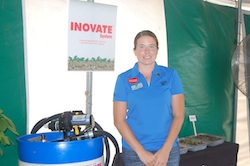 Refsell said that so far farmers have been very happy with the product and she explained that they’re getting great results with stand establishment as they’re going out doing stand counts with all the growers. They’ve also seen increases in plant vigor.
Refsell said that so far farmers have been very happy with the product and she explained that they’re getting great results with stand establishment as they’re going out doing stand counts with all the growers. They’ve also seen increases in plant vigor.
A product in the pipeline is FIERCE that will be available for soybeans and no-till corn. Refsell said the use pattern for soybeans is exactly like VALOR, which is a component of FIERCE. She said it can be planted up to 7 days before planting. Valent is expecting registration on the product during 4th Quarter of this year so they are positioning it mainly for Spring.
One last product they are launching is RYZUP, which is a biological. It focuses on grass pastures and it can be applied to extend the grazing season up to 3 weeks. It should be applied when the temperature is between 40-70 degrees because during this time grass is slower to grow.
To learn more about these new Valent products, listen to my interview with Dawn Refsell or visit their website at www.valent.com.Valent Launching Three New Products
Check out our Farm Progress Photo Album.
